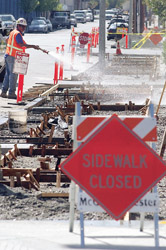
Hollister RDA hopes downtown investment, affordable housing will
spur growth
As the ongoing recession continues to stall economic
development, the Hollister Redevelopment Agency plans to invest in
community revitalization projects through the second half of the
current fiscal year.
Hollister RDA hopes downtown investment, affordable housing will spur growth
As the ongoing recession continues to stall economic development, the Hollister Redevelopment Agency plans to invest in community revitalization projects through the second half of the current fiscal year.
From the continuation of downtown facade and streetscape programs to the demolition and redevelopment of the former Fremont School and Leatherback Industries sites, RDA Executive Director Bill Chow remains optimistic that brighter times are ahead for the city.
“I’ve never seen the economy this bad,” said Chow, who has been on the job for four months. “I’ve seen a downtown in this situation, but not when the economy is in this situation, too. That’s the scary part. I think it’ll turn around; it just might be awhile – maybe a year.”
In the meantime, the RDA has committed to funding projects designed to spur both retail and housing development in Hollister.
Downtown streetscapes
Once the Hwy. 25 bypass around Hollister is completed in the coming months, Chow said Phase II of the Downtown Streetscape Project will begin. The northern part of the downtown area, from Third to North streets, will receive new sidewalk pavers, street lights and benches, continuing work previously done throughout the rest of downtown.
“We have a chance to revitalize the downtown area when business is slowing down,” Chow said. “It gives us a chance to make it more pedestrian-friendly and hopefully people will be more likely to walk down there.”
Brenda Weatherly, executive director of the Hollister Downtown Association, said continuing the streetscape improvements northward gives the area “a sense of belonging together.”
Promoting downtown
The RDA is continuing its support of the downtown association to help promote the benefits of retail, commercial and industrial development in the area.
“The RDA is funding the HDA to make sure there’s a voice for the downtown business people,” Chow said, noting that as a newcomer to town, he benefits from the insights of the association. “It helps me a lot to be able to get input from business groups. It helps you find out what the issues are that sometimes you don’t hear from other people or from [city] staff.”
The nonprofit HDA receives approximately a quarter of its budget from the redevelopment agency.
“The city doesn’t just support us financially,” Weatherly said. “They help us with programs that are ultimately beneficial for all of downtown.”
The city’s facade improvement program, which provides low-interest loans to fund the rehabilitation of commercial building fronts in the downtown district, will continue through the summer as well.
“We want to make a comprehensive effort to revitalize the downtown and make it as attractive as possible,” Chow said.
Tearing down, building up
Larger projects in which the RDA has a stake, including the redevelopment of the former Fremont School and Leatherback sites, are moving forward as the new year approaches.
An environmental cleanup of the Fremont School location on Fourth Street, which is slated to become the site for the new county courthouse, has included the removal of asbestos and lead paint in advance of demolition work.
After the Hollister City Council certifies the environmental review of the site, the city will seek bids for the demolition of the site.
“It’s been moving along at a pretty good pace,” Chow said. “We’re moving really fast on this project.”
Across town at the former Leatherback facility on McCray Street, which the RDA purchased for $4 million in June, the city is reevaluating potential uses for the site, which has been envisioned as a mixed-use residential and commercial development.
“Given the economic climate in Hollister, in the state, and even nationally, we’re going to have to re-evaluate what project to move forward with there,” Chow said. “More of a high-density residential use could be an option. We’ll have to see how thing are turning around for the private sector, including banks.”
A wait-and-see approach
Despite the lifting this month of the state-imposed moratorium on new sewer connections, developers and entrepreneurs may still be reluctant to invest in retail or residential projects until they are confident the economy is on the rebound, Chow said.
“We want to see how President-Elect Obama’s economic plan moves forward,” he said. “He knows the economy is in pretty bad shape and the president needs to take a more proactive approach in stimulating the economy than the current president has.
“I expect that to happen,” Chow said. “Hopefully, that’ll signal to the various stakeholders in the community – the business people, the developers, and the financial people – that the start of the recovery will begin.”
Many of Chow’s developer contacts said they aren’t willing to commit to commercial projects until economic conditions improve, he said.
“They want to wait and see, too,” Chow said. “March or April might be a good time to approach them to see how they feel.”
Making housing affordable
On the housing side, the RDA’s mortgage assistance program, which allocated $500,000 to offer 1 percent second mortgages of up to $50,000 for local first-time homebuyers, generated less interest than Chow expected.
“I was surprised by the limited amount of applications,” he said, noting that six people had applied for the loans by last Friday’s deadline. “With the economy the way it is, people don’t want to buy houses,” even when they are offered a mortgage that has no monthly payments and would not have to be repaid as long as the person didn’t sell or transfer the property.
The program was conceived in the wake of high foreclosure rates as a way to help up to 10 families who earn less than the county’s median income (approximately $72,000) get into a new home.
Since not all of the money allocated for the program is expected to be used, Chow said the redevelopment agency may redirect some of those funds on a housing rehabilitation program.
Affordable housing projects planned in conjunction with South County Housing, such as the Vista Meadows low-income senior housing project planned for Park Street near Rancho San Justo School and the Hillview project on Central Avenue, could help the local economy, Chow said.
“I’ve had people say they don’t want more affordable housing in our city because we don’t need more poor people,” he said. “People have to realize that poor people may not have that much money but they can still afford to pay the rent and they spend a majority of their income on goods. If you cater to them, you will make money.”
Chow said even developments that are focused on the low-income or affordable markets can bring money into Hollister.
“Any time you spend money in the city of Hollister, there’s a multiplier effect,” he said. “The people who develop and build here will spend money and the people who live there will spend their disposable income in Hollister. The business community has slowly recognized that there is profit to be made from a diversified market segment.”









